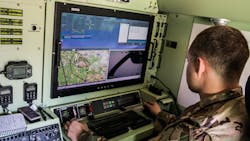Air Force asks industry to develop digital signal processing automation for signals intelligence (SIGINT)
ROME, N.Y. – U.S. Air Force researchers are asking industry to develop cyber security and signals intelligence (SIGINT) real-time digital signal processing for the intelligence community.
Officials of the Air Force Research Laboratory's Information Directorate in Rome, N.Y., have released a broad agency announcement () for the Signals Intelligence (SIGINT) Solutions for Evolving Scenarios (SSES) project.
SSES seeks to improve tactical information collection, geolocation, extraction, identification, analysis, simulation, and reporting in support of the intelligence community.
Goals include providing situational awareness for worldwide signals and network intelligence sources; sensor data collection and digital signal processing with a network-centric approach; multi-platform/multi-intelligence support to protect and increase the blue coalition warfighting capabilities; and understanding the adversarial battlespace.
A key objective is to advance state-of-the-art real-time tools to assess and pinpoint the right decision quickly to mitigate threads and ensure battlespace dominance. The SSES project first was announced in 2022, and extends through 2028.
SSES enabling technologies are to support the command, control, communications, computers, and intelligence (C4I) and cyber, science, technology, research and development vision, protect blue coalition forces with command, control, computer and intelligence applications, and support battlespace awareness for the warfighter.
The Air Force is particularly interested in multi-agency systems that rely on open architectures with scalable technologies for quick-reaction capabilities and heretofore undemonstrated technical capabilities based on warfighter needs.
Information extraction for SIGINT focuses on new processing techniques to provide decision-makers with C4I information in as near real-time as possible.
Related: Air Force considers digital signal processing for improved SIGINT and cyber intelligence
Solutions should be able to operate in low-signal-to-noise ratio environments against targets where the noise types and channel conditions are frequently varying from message to message, with a goal of automating SIGINT collection, processing, and exploitation in tasking and training. SSES has three broad technology areas: information extraction, signal processing, and automation.
Information extraction seeks to identify and catalog signals of interest. Signal processing seeks to remove noise and interference. Automation seeks to automate signal-processing tasks to manipulate the signals of interest for storage and transmission.
Another focus is to develop algorithms to identify, collect, process, and exploit electronic communication signals in a moderate-to-dense co-channel environment with potentially significant Doppler effects.
Related: Black River to pursue SIGINT enabling technologies in software-defined radio
Goals are to detect, identify, and locate emerging communications and low-power signals of interest; provide systems and waveforms; develop new software and hardware architectures for standoff collection; and characterize cognitive, software-defined radios from aircraft and land vehicles in dense signal environments. Air Force researchers want to capitalize on existing cyber and signal processing technology from academia and industry.
Companies interested should email white papers to the Air Force's Todd Howlett at [email protected], who will take white papers until 13 Aug. 2027. Those submitting promising white payers may be asked to submit formal proposals.
Email questions or concerns to the Air Force's Amber Buckley at [email protected]. More information is online at https://sam.gov/opp/cb2c4019800049f5ab45c3ee51ae4a72/view.

